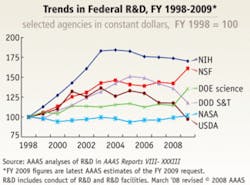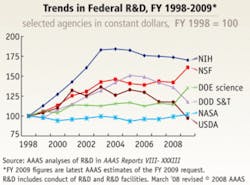When President George W. Bush unveiled his $3.1 trillion federal budget for fiscal year 2009, biomedical research advocates were hoping this year might be the year of the “bump”—a cost-of-living increase for research. Unfortunately, for the sixth straight year, there will be no boost. In fact, according to a report issued by the Federation of American Societies for Experimental Biology (FASEB), the National Institutes of Health (NIH) budget has actually contracted from $31.7 billion in FY2004 to a projected $27.5 billion in FY2009 in constant dollars (see table).
Each year since 2003, when Congress doubled NIH’s budget, biomedical research advocates have looked for a “soft landing”—a step back from the boom years, but still with room for growth.
“We’re better off having doubled the budget, but no one expected this hard landing,” says Carrie Wolinetz director of Scientific Affairs and Public Relations for the Federation of American Societies for Experimental Biology (FASEB). “It’s like building a new house and not having a budget to maintain the house. It’s not the best strategy.”
FASEB calculates that NIH’s purchasing power has dropped 13% since 2003 as a result of flat budgets and inflation, and they say this trend will continue if the funding situation remains. The full-blown impact has yet to hit because academia and professional societies are taking up the slack with bridge funding.
Fewer dollars for rats and test tubes is bad enough, but Wolinetz thinks the worst is yet to come. Fewer dollars eventually translate into conservative research.
“It’s a very tough balancing act,” she says. “People want innovative research without risk.” With a decline in applications success rates will increase, “but who are we losing?” she asks. “Study sections get wonderful applications but have to choose between really good projects. What if a cure for Alzheimer’s disease is left on the floor because there was no money?”
Advocates for biomedical research would like to see Congress develop a permanent funding plan that keeps up with inflation. While no one expects doubling to occur, appropriations that are sustainable, such as 3% to 4% annually, would help agencies maintain their buying power. The NIH Reform Act of 2006, which reauthorized the agency, gave specific budget numbers for FY2007 ($30 billion) and FY2008 ($33 billion) but stopped short of attaching a number to FY2009, providing only the following language: “and such sums as may be necessary for FY 2009.”
During the 1990s, federal funding experts debated whether biomedical research should become an entitlement program but entitlements usually receive flat funding (see figure). “During the doubling period, appropriations seemed the way to go,” says Kei Koizumi, director of the American Association for the Advancement of Science’s R&D Budget and Policy Program. “Very few R&D programs are entitlements.”
Rebalancing the R&D portfolio
The federal R&D budget reflects the administration’s desire to promote areas that were neglected while the NIH run-up occurred between 1998 and 2003. “The immediate goal seems to be to increase the physical sciences,” says Lynn Marquis, executive director of the Coalition of Life Sciences. “It’s as though they looked around and said ‘what’s the next science we should support?’ ”
A major driver behind the proposed physical sciences increases is the America Competes Act, signed into law in August 2007. The act describes the role the federal government plays in supporting basic research and education and the important relationship between federal research and U.S. competitiveness. It also includes steps for doubling the federal budget for long-term basic research within 10 years.
Reality, however, has a way of dimming even the most noble of actions. The Consolidated Appropriations Act for FY2008 fell short of providing the funds needed to push the budgets of National Science Foundation, the National Institutes of Standards and Technology (NIST) and the Department of Energy’s Office of Science toward the doubling path. The same may well occur this year. One of NIST’s key programs to spur innovation, the Technology Innovation Program, successor to the agency’s Advanced Technology Program, is not funded in the FY2009 budget. The money for this program was shifted to the NIST labs.
But even the proposed increases for physical sciences are not large enough to improve the government’s overall investment in research and development. “The government had surpluses during the [NIH] doubling period, but since then the government has been in regular deficits,” Koizumi says. “Unless the situation changes, it will be very difficult for an agency as large as NIH.”
While observers note that the U.S. R&D enterprise has plenty of champions on Capitol Hill, including Arlen Specter (R-PA), Tom Harkin (D-IA), Ed Markey (D-MA), and Christopher Shays (R-CT), the number of domestic programs competing for the available discretionary funds makes science funding increases a tough sell. “There are so many priorities in the House, NIH has fallen to 10th in the level of support,” says Marquis.
How much is enough?
In the first quarter of the year Congress has done its best to put additional money into the budget, but it is unclear whether that money will translate into real dollars for researchers. President Bush is still irked by the number of earmarks (the assignment of money during the legislative process for use by a specific organization or project) Congress inserted into the FY2008 budget and has again threatened to veto any budget that does not limit the number of earmarks to half of the previous year’s total. The Office of Science and Technology Policy estimates that research earmarks were nearly $2 billion of the $16.8 billion of overall appropriations earmarks government-wide in FY 2008.
To compound the paltry spending amounts, observers say it’s unlikely a budget will pass before the November elections. AAAS’s Koizumi suggests passage may even get pushed until after the inauguration. He predicts a win for the Democrats could help federal R&D spending, but a Republican win would likely continue the status quo.
Key agencies by the numbers
Combing through the 2009 federal science budget, few bright spots emerge. One plus is the National Science Foundation’s Engineering Directorate, slated to receive $759 million, a 19% increase over FY2008. Within that unit, Chemical, Bioengineering, Environmental and Transport Systems which includes bio-optics programs would receive $173 million, a 32% increase over FY2008. The Office of Emerging Frontiers in Research and Innovation which supports interdisciplinary, high-risk research would receive $4 million. Overall, NSF is in line to receive $6.85 billion.
At DOE’s Office of Science, life-sciences research is slated to receive $568 million, a 4% increase over FY2008. Overall, the Office of Science is requesting $4.72 billion.
NIST’s entire R&D FY2009 request comes in at $546 million, a nearly 5% jump from FY2008. As noted by AAAS, the increases would go only to NIST’s intramural laboratories and intramural construction, and would be offset by steep cuts in NIST’s external programs.
While funding for NIH, falls short in the budget, other programs that may gain during this cycle include basic and advanced research for bioterrorism preparedness ($4.3 billion) and the Biomedical Advanced Research and Development Authority for R&D on biomedical countermeasures, which will see a $250 million allocation (FY2008).
REFERENCE
www.aaas.org/spp/rd/fy09.htm
About the Author


